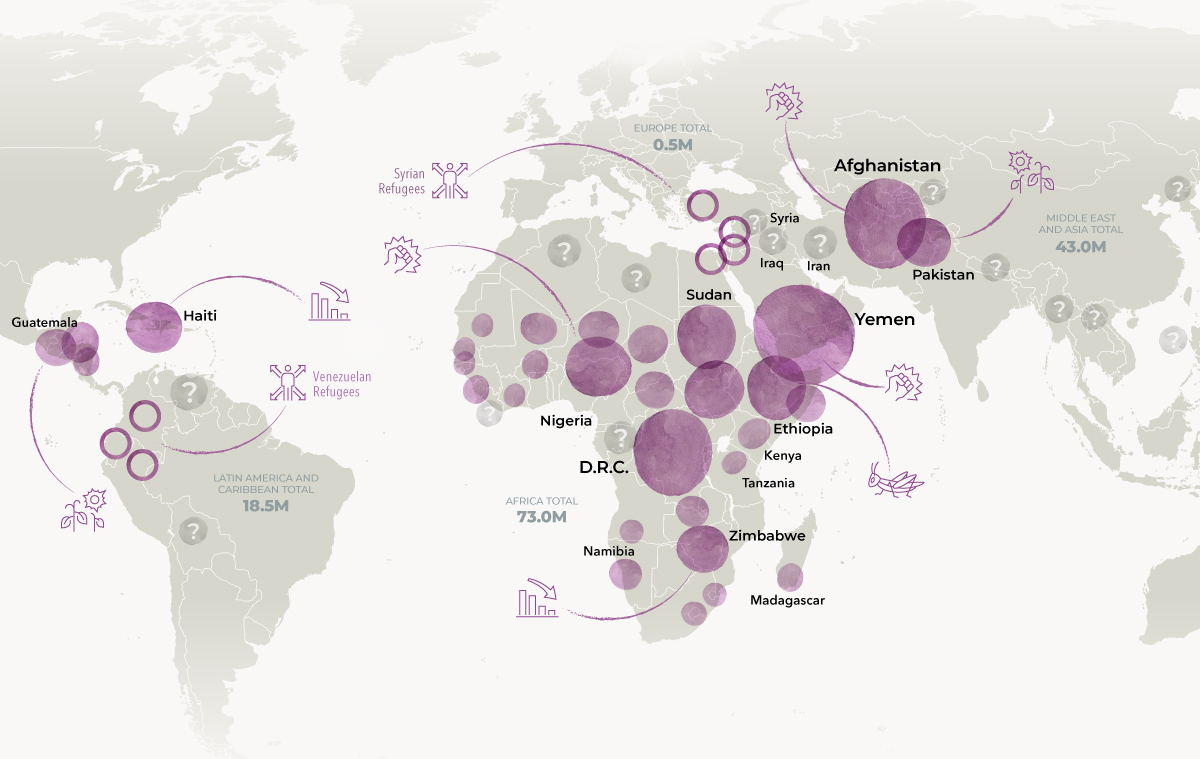2020 Global Food Crisis Report Indicates “Crisis”

“The number of people on hunger threshold may double due to the global epidemic.” While Covid-19 news fills the tabloids on one hand, another emergency that is food safety threatens people's lives on the other. According to the 2020 Global Food Crisis Report, while 135 million people are already on the threshold of hunger in the global scale, there is a possibility that this number will increase to 265 million by the end of the year.
The fourth report which was prepared this year focuses on the increasing likelihood of acute food hazard which has a major impact on life and livelihoods.
The report addresses the hazard related to food safety in five different categories: minimum, tense, in crisis, emergency and disaster. According to the report scale, while 135 million people are already on the hunger threshold, urgent measures are needed to alleviate these effects beginning from Stage 3. The distribution of this figure by some countries is as follows:
Prominent Countries In Food Crisis 2019
| Country | Analyzed Total Population | Number Of People On Hunger Threshold | Ratio of Analyzed Population |
| Afghanistan | |||
| Angola | |||
| Central African Republic | |||
| Columbia (Venezualen Immigrants) | |||
| Equator (Venezualen Immigrants) | |||
| Haiti | |||
| Pakistan (Baluchistan +Sindh) | |||
| Total |
Another point highlighted by the report is that approximately 75 million children in 55 analyzed countries have limited access to adequate nutrition, clean drinking water and health care to help sustain their lives… 17 million of these children struggle with acute nutritional deficiencies. The report emphasizes that the main causes of acute food insecurity in 2020 will be conflicts in the international system, bad weather, desert locust, economic shocks and the Covid-19 outbreak.
According to the report prepared with 16 different partner organizations, there is a possibility that the number of people in hunger crisis would increase to 265 million due to the crisis brought about by the Covid-19 epidemic, if no precautions will be taken. The figure in question roughly approaches the US population. The African continent covers the large scale of the hunger crisis.
Factors That Negatively Affect Food Safety In 2020
Conflicts and Insecurity
Economic Shocks
Covid-19 Crisis
Weather Conditions
Locusts
Immigration
The report underlines that the acute food insecurity estimates for 2020 began to be penned before Covid-19 had become an epidemic, and therefore more negative results can be expected. According to the report, when war, economic shocks, combined effects of crop pests, and finally the epidemic crisis are added, Yemen is the country that is most affected by the food crisis.
In East Africa, the abundant seasonal rains have served crops and pastures on one hand, a serious desert locust invasion that would directly affect food insecurity threatens the region on the other. The UN reports that East African countries currently struggling with the Covid-19 outbreak may encounter a desert locust invasion 20 times larger than their predecessors in the coming rain season. While the herds of desert locusts that have been damaging the fields in East Africa and Middle East countries for months can travel 150 kilometers every day and 40-80 million locusts per square kilometer can destroy enough food for 35 thousand people in just 1 day.
Severe conflicts and the gradual devaluation of the currency of the countries, that is, the decline in purchasing power are among the most important problems of the Middle East and Central Asian countries. This situation brings along the factors that directly threaten acute levels of malnutrition especially for children.
According to the report, in Latin America and the Caribbean, sociopolitical crises, excessive weather conditions, lack of employment and high food prices will lead to the loss of acute food insecurity in some countries.
The epidemic is strong enough to falsify food security and livelihoods especially in the fragile agricultural sector while the global recession will shake the food supply chain to a large extent.
Inequalities in the Humanitarian Aid Distribution in 2018
Yemen
Democratic Republic of Congo
Afghanistan
Syria
Sudan
East Sudan
Populations Without Acute Food Safety (IPC-3 and above)
Populations Which Receive Humanitarian Aid (Billion Dollars)
According to the report, 106 million people from 32 countries were examined in the scale defined as acute hunger (IPC / CH Phase 3 or higher) in 2018. As expected, agriculture and nutrition aid made up a large part of humanitarian aid. But in countries such as Yemen, the Democratic Republic of Congo, Afghanistan, Syria, Sudan and South Sudan, there was a deep disparity between the mass in need of humanitarian aid and the ones who could reach humanitarian aid. However, in Yemen, the Democratic Republic of the Congo and Afghanistan, there were more than 10 million people in need and who suffer from acute food deficiency, but Yemen received five times the humanitarian aid of the Democratic Republic of the Congo and seven times the aid of Afghanistan. Similarly, 6-6.5 million people in each of South Sudan, Syria and Sudan faced acute food insecurity and had similar needs, while South Sudan and Syria received almost four times more aid than Sudan.
Africa Under Risk!
While food insecurity deeply affects the world population, Africa faces a greater threat than other continents. The report emphasized that 73 million people are facing food crisis, while a large part of the population in question is in the sub-Saharan Africa region. In the African continent, the Democratic Republic of Congo stands out, where 15 million people face an acute food crisis. The country has been experiencing intense armed clashes since March, and the risk of Ebola’s reappearance in the region stands as another crisis area.
Food Insecurity In Africa 2020
73 million people under risk!
Military Conflicts and Migration Stand Out in the Middle East!
In the Middle East, 43 million people are trying to cope with similar difficulties in Africa. According to the analysis, Yemen which is the most insecure country in the world with a population of 15.9 million, is the only geography where food insecurity is at the “Disaster” level (IPC / CH-Stage 5) due to the proxy wars that have been going on for almost 3 years!
Food Insecurity in the Middle East 2020
43 million people under risk!
Another problematic region is Afghanistan, where 1.3 million people are at a critical threshold concerning acute food insecurity! In the January-March 2020 period, 138,000 immigrants from Iran and Pakistan had to return to their country, which increased the burden of food resources. While more than half (51%) of the Pakistani population analyzed are facing the highest acute food insecurity in Asia, the situation is getting worse due to extreme weather conditions such as monsoon rains below average.
Conclusion
According to the report, as the global economy will contract due to the Covid-19 crisis, funding cuts can be encountered in large humanitarian organizations. According to the World Food Program President, 300,000 people may die every day due to the food crisis. The report also warns that these projections are still inadequate due to large data gaps and ongoing challenges. For example, 16 countries such as Iran or Philippines could not be included in the analysis due to insufficient data. The warning of Visual Capitalis expert Iman Gosh, who analyzed the report is remarkable: “When the dust cloud by Covid-19 virus cleared, we will see the food crisis more clearly.”
Resources

Bizi Takip Edin